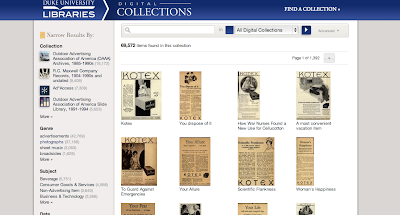The arrangement and description of collections is important, for it is the key to retrieval and providing good access to one's collections is one of (if not 'the') main functions of an archive. Photographic materials in particular benefit from description, for they help convey meaning of materials that frequently lack identifiers as, "without verbal description, many still pictures convey little meaning" (Ritzenthaler 166). The online catalogs I investigated for this assignment were the digital collections from the UCLA Library (http://digital2.library.ucla.edu/) and the Duke University Library (http://library.duke.edu/digitalcollections/).
UCLA Library Digital Collections
The opening page begins with one looking at various collections. Collections are listed in alphabetical order when initially browsing. The search bar allows one to also limit there search by titles, names, and subjects. I choose clicked on the "ARKATOV (JAMES) COLLECTION", which contains 786 images.
One can browse this collection by 'Language', 'Name', 'Subject' or 'Type'. One of the photos I choose to focus on was "Aaron Copland at the podium, Los Angeles, 1960 [descriptive]".
The page for this item contains a thumbnail of the photo as well as the record. Clicking on the thumbnail brings up a window where one is allowed to zoom in and out of the photo to various degrees.
The metadata for each individual item is thorough (there are various access points), and the descriptions tend to be rather full. The institutions commitment to standards can be viewed in these fields, as both MARC and LC Names Authority Files are used. A disappointing aspect however, is that the 'type' of photograph sections are not very specific: 'black and white photo' is as descriptive as any of these items get.
Duke University Library Digital Collections
In contrast to the UCLA site, when first browsing I was shown items rather than collections. I then clicked on 'Photographs' as one could sort by 'Genre' (There is also the ability to narrow your browsing results by 'Collection', 'Subject', and 'Date').
The photo I selected to look at in detail was 'Standing boy dressed in formal wear, unidentified'.
The zooming effect on this photo is not as powerful as the one used in the UCLA collections. The metadata is also more scarce, and access points are lacking. Subject headings are non-existent. Like the UCLA collections however, the 'type' of photograph sections are not very specific. Unlike the UCLA collections, Duke allows users to comment on items.
Conclusions
The websites were very easy to maneuver through and quite modern looking. This appeal and ease of use made me want to continue browsing throughout my experience. The limited description in 'type' of photograph in both repositories seems to be a common occurrence (also seen in our class examples) and may say something about the descriptive practices of photographic materials. Both places only described items, and failed to provide any collection level description (it may also be beneficial to note that finding aids are not included on either site). Overall, descriptive practices of items seemed to be adequate (with UCLA being a bit more thorough), but both could use improvement. Without collection level description however, it seems as though access to these items is severely limited.
References
Mahard, Martha. Class Lectures. Spring 2013.
Ritzenthaler, Mary L, and Diane Vogt-O'Connor. Photographs: Archival Care and Management. Chicago: Society of American Archivists, 2006.






No comments:
Post a Comment